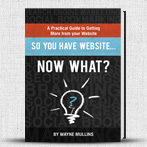Dan Kennedy Reveals – How to Get Prospects to Say Yes, and Why Prospects Say No
Great news! Learning how to get prospects to say yes is simple. All you have to do is offer them what they most want to buy. It’s really that simple…and at the same time that complex.
At the SuperConference, Dan discussed the importance of being strategic with regard to selling. If you approach selling casually, you will get casual results. If you approach selling strategically, you will drastically increase your closing rate and reduce uncertainty, which is a major stress factor.
How do you get prospects to say yes?
Commit to Getting a Yes
Most sales trainers set their trainees up for failure. They have good intentions, but these intentions hurt the trainees ability to effectively sell. Sales trainers want to do their best to prepare their trainees for the “real world” of selling. They teach that sales is a numbers game. Depending on the industry they are teaching, they say something like, “only 2 out of 10 prospects will buy from you. So, when someone says ‘no’ you have to quickly move on to the next prospect.”
When trainers teach this way, they subconsciously train their salespeople to expect to hear “no” often. Worse, they have trained them to give up on the customer the first time they say “no”. In reality, the best salespeople are those who are committed to getting the “yes”. They are the ones who hear the word “no” and then work diligently and passionately to get the prospect to say yes.
How committed are you to getting a “yes” from your prospects? Do you truly believe in what you’re selling?
Sell to Those Willing & Ready to Buy NOW
How much stress would exit your life if you never had to make a cold call again? Imagine having a list of people eagerly waiting to hand you money. That would be awesome..right!?! Well if you are willing and committed to getting a “yes”, then you must also be willing and ready to approach selling strategically. One strategic approach to selling your product or service may look something like this:
-you identify prospects that could benefit from your product or service,
-you call to schedule an appointment with the prospect,
-you present your product or service to prospect,
-the prospect decides to buy (or not buy),
-you move on to the next prospect.
Look familiar? Now, let’s revise your strategy:
-You identify a group of suspects (those you believe could become prospects)
-you send them something that identifies and heightens the significance of their problem
-it offers them a solution to their problem, positions you as THE logical solution to their problem, and tells them what to do next if they’d like to purchase from you.
Do you see the difference in these two approaches? While both are strategic, only one of them is both strategic and scalable. Only one of these approaches allows you to present your product or services to those willing and ready to buy. So which strategy do you like best?
Be Willing to Override Their Habits
If you’re not committed to getting a “yes” and don’t truly believe in what you’re selling, you don’t stand a chance of overriding their poor purchasing habits. You won’t even have the will to do so. Remember, most people have very poor purchasing habits – in large part due to indecisiveness. To succeed in sales, you must be willing to override their purchasing habits.
By following, and actually implementing, the steps outlined above you’ll no doubt increase your sales closing rate. If you really want to see a significant improvement in your closing rate, study how to get people to say “yes”. More importantly, study why people say “no”.
Why Prospects Say No
1. Poorly Prepared Prospect
How can you prepare a prospect? Well, you can’t if you’re cold calling, which I hope you never do. I believe cold calling is the lazy person’s approach to selling. Cold calling starts the entire sales process off on the wrong foot. It places you as the person in need. In reality your prospect should be the person in need. You shouldn’t be perceived as needy. Instead, you should be seen as the trusted adviser.
You prepare the prospect by positioning yourself as the trusted expert and helping them see their need. In order to do this, you have to be in communication with your prospect prior to your actual meeting.
2. Poorly Prepared Salesman
Most salespeople approach each prospect the exact same way…and this is a HUGE mistake. If you’re treating each prospect the same, this means that you’re not properly prepared. You need to know, and understand, your prospects needs, desires, purchasing habits, and problems. If you don’t know, you aren’t prepared.
3. Two Different Starting Positions
You believe they have X problem, but in reality they have Y. So, you approach them selling the solution to X, but they’re trying to find the solution to Y. You’ve both started from two different positions. This is why it’s vital that you know and understand your prospects.
4. Environmental Mis-Cues
Over 80% of what your prospects hear comes, not from what you say, but how you say it. This 80% includes your non-verbal communication (your posture, the rhythm you in which you speak, the tone of your voice, etc) as well as the environment (your clothes, your office, you vehicle, the way your receptionist answers the phone) you in which you are selling. (I’ll discuss more about environment in the near future).
5. Perceived As a Typical Salesman
There is only a subtle difference between being seen as a typical salesman and a highly trusted adviser. Although the difference is subtle, the negative effects of being seen as a typical salesman can be completely devastating. You need to work on building a frame that positions you correctly in your prospects minds.
6. Insufficient Diagnosis
This is very similar to number 3 – the difference is an insufficient diagnosis and is likely the result of two particular things: 1. – you haven’t done your homework on your prospect; 2. – you’re not asking the right questions. If you’re presenting to a prospect, it is now your job to determine their true needs, wants, and desires, and then position your product or service in a way that fulfills those items.
7. Dog on the Roof of the Car
Maybe not to you, but to some, placing a dog on the roof of a car is animal cruelty. Your dog may love heights, and may actually enjoy sitting on the roof of your car. However, it doesn’t matter what you think if your nosy neighbor decides to report you to ASPCA for animal cruelty. The same is true in selling. It doesn’t matter comfortable you are with your selling process, all that matters is what makes your prospect feel comfortable.
8. No Box
As a successful salesperson, your job is to build a box for your prospect. Without this box, the likelihood of a sale is minimal. If you successfully build a box, though, you’ve all but guaranteed yourself success. So what’s a box? Glad you asked. A box is simply a list of all the reasons your prospect won’t buy today. It could be the price, they don’t know if the widget does everything you say it will do, etc.
Once they have told you all the reasons they can’t buy today, now it’s time for you to start constructing the box. The simplest way of doing this is by saying, “so Mr. Prospect, if I can show you how this widget will not only pay for itself in only three months, and how it will do everything you ever hoped and dreamed a widget could do, will you be ready to purchase today?” If they say “no” then you have to keep building your box. If they say “yes” well now it’s time to begin overcoming all their objections.
The box is likely the most powerful, yet most overlooked, selling technique at your disposal.
What They Must Ask if They Are Going to Buy
Did you know there are three questions that will let you know when it’s time to pull out your order form? Well there are, and if you hear your prospect asking any of these three questions, stop selling, and start writing the order. Here are the three questions:
-How can you help with this?-What’s next?-How do I work with you?
Conclusion
Despite what many of the gurus teach, selling isn’t a game of numbers. Instead it’s as Zig says, “a transference of feeling.” If you don’t truly believe in what you’re selling then all hope is already lost, and all these techniques and strategies will do you no good. But if you believe – yes, truly believe in what you’re selling-then these techniques will help you hear yes a LOT more often.
Enjoy this post? Do me a favor and click here to share it on Facebook, or here to share it on Twitter.
- Likes, Shares, & Comments WON'T Put Money In Your Bank Account.
- In Our Free Course: Crush It On Facebook In 30-Days Or Less
- You'll Discover: A Simple Facebook Strategy We Used To Take a Client From Losing $10k Each Month To Making Thousands...In Only 86 Days.
- The 3-Step Formula We Used To Increase Another Client's Sales By Over $9,000 per Month (and they're spending less than $400 per month on Facebook Ads)



